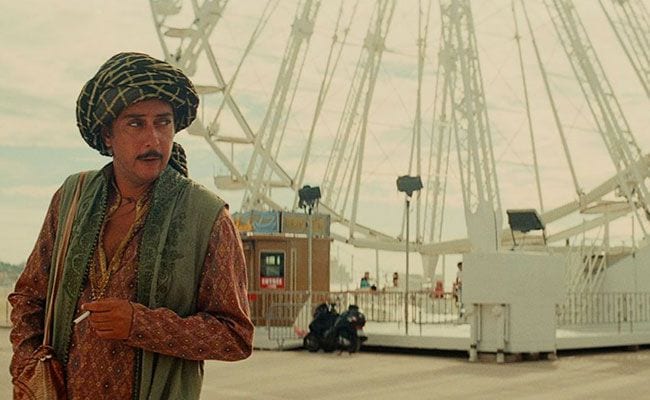
From the opening credits of Arabian Nights, the 2015 trilogy of films from Portugal’s Miguel Gomes, it’s made clear that this work isn’t directly based on the classic Persian stories of the same name, but inspired by events that happened in Portugal during its economic crisis of the last few years. Actually, it’s a gonzo mixture of the two, for the beautiful Scheherazade (played by Crista Alfaiate, who also plays several other roles) is still preserving her life by stringing along the Caliph with cliffhanging stories every night. It’s just that those stories are somehow aware of what’s happening in Portugal centuries later, and the stories mix documentary realism with whimsical fantasy elements like wizards and genies.
At the beginning of the first film, Arabian Nights: Volume 1 — The Restless One, Gomes appears as himself, a filmmaker who runs away at the thought of somehow combining his impulse to document real people and their stories, such as unemployed dockworkers, apartment dwellers, people caught up in bizarre court cases (one involving a noisy rooster), and people who raise finches, with the fantastical elements of escapism and magic.
Gomes never resolves the contradiction, he just makes a sui generis film in which long stretches of footage feature interviews with real people juxtaposed with various activities, and every once in a while a whimsical tale gets dramatized. It exists in its own aesthetic world, characterized by crystalline widescreen compositions, swathes of color, bursts of music (especially various versions of “Perfidia”) and a languorous sense of time and place that will test the patience of those looking for traditional stories, or those who don’t wish to sink into its meditation of a specific country’s melancholic mood refracted through fantasy.
This sometimes included myself, whom I consider to be a generous viewer. Something in every film captivates my interest, and something makes my fingers itch for the fast-forward button. The first film includes a bawdy story in which the EU representatives and bankers deciding the country’s fate are afflicted by their greed for erections that won’t quit. This story begins after 25 minutes of documentary material, after which the opening credits finally arrive! Then come stories about the rooster, who crows a tale about a romance gone wrong, and people who participate in an annual swimming ritual.
The second film, Arabian Nights: Volume 2 — The Desolate One, dramatizes fragments about a criminal on the run, then a wonderfully whimsical theatrical piece set in an outdoor stadium, in which a female judge listens to an endless tangle of testimonies, confessions, and complaints from everyone, including a genie and a horse. Then we follow a story about an adorable dog and the sad lives of its new owners.
The first half of the concluding film, Arabian Nights: Volume 3 — The Enchanted One, is an intuitively constructed series of sequences and characters combining ancient characters with modern ones in the same rocky coastal setting, and it achieves a dreamlike texture. The last half, which is entirely too long, dwells on the many men who invest their emotions in the hobby of breeding and training finches for various contests, with an interruption for a short narrative by a visiting Chinese woman spoken over images of political demonstrations.
The effect of the trilogy is to convey a socio-historical mood of Portugal today as a canvas of struggling people trapped between disaffection and resignation, with undercurrents of anger and despair. It could have been a straight documentary, but Gomes chose to lace it with “entertainment” as a kind of subversive gesture implying hope and optimism, and reminding us that we make stories of our lives in order to keep ourselves alive.
One wise decision of this American Blu-ray package is that the frequent on-screen narratives and titles are presented in English, so that viewers aren’t confronted with a stream of subtitled clutter. Aside from the trailer, the only bonus on this Blu-ray set is Gomes’ Redemption, a half-hour collage of footage from newsreels and documentaries, plus one scene from De Sica’s Miracle in Milan (1951), that has tangential connections to four soliloquies on the soundtrack: a Portuguese boy, an old Italian man, a French father, and a German bride, all affected in some way by their country’s politics.
The ending reveals the connection between these true-life historical characters and the fact that the letters are invented. The German section, with Wagner’s music, is the most avant-garde and beautiful.


![Call for Papers: All Things Reconsidered [MUSIC] May-August 2024](https://www.popmatters.com/wp-content/uploads/2024/04/all-things-reconsidered-call-music-may-2024-720x380.jpg)



